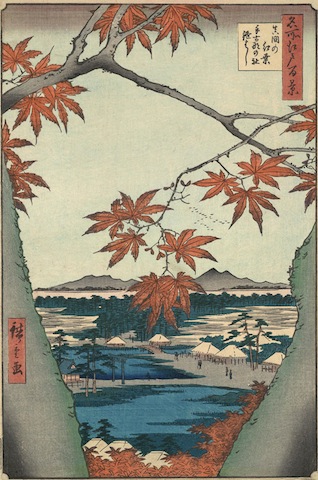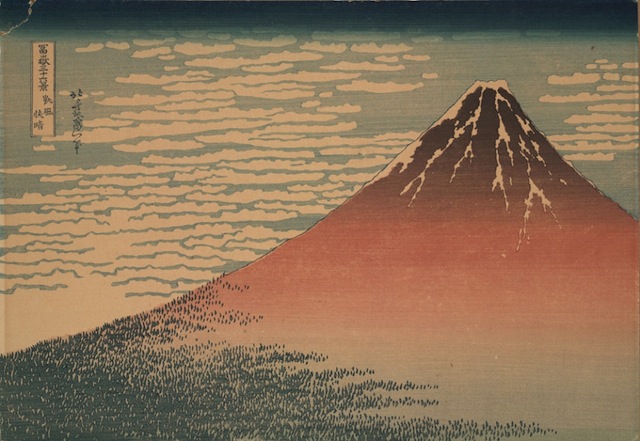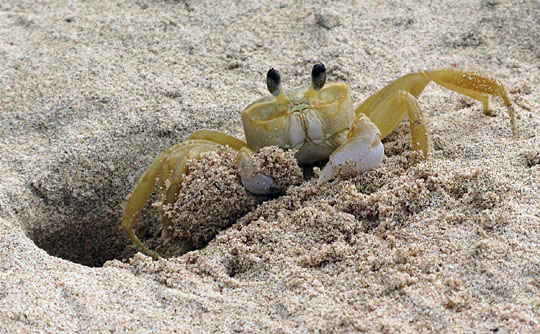
Ukiyo-e, ‘pictures of the floating world’: Utagawa Hiroshige (Japanese, 1797–1858), Maple Leaves at Mama, Tekona Shrine, and Linked Bridge, #94 from the series One Hundred Famous Views of Edo, 1857. Color woodblock print. Bequest of William P. Chapman, Jr.
In my Japanese history class, my instructor made the following comment: “The Japanese abhor unpredictability to the extent that they have landscaped and cemented over so much of Mother Nature that it makes you wonder whatever happened to the Romantic fiction and nature-worship of their ‘floating world.’”
This past summer, I went on a field trip with my students to the Polynesian Cultural Center. We ended it with a cinematic treat, the movie Hawaiian Journey. Plumeria scented mists and moving seats propelled us into the captivating sights and sounds of old Hawaii. Lush forests, crashing waves and soaring heights left us breathless and gasping. Then the narrator said, “Look to the land to find out who you are.”
As I look at a calendar of Japanese woodblock prints, I find myself thinking about Japan and its land. Modern Japan is a predictable “forest” of buildings and factories, “crashing” with the sounds of traffic and “soaring” skyscrapers. Is that the land? What about the people? Have they become disconnected from nature, “landscaped and cemented” from the nature-worship of the land? What about old Japan? Were all the people predictable or did some embrace open-ended possibilities? Can the Japanese today really look to Mother Nature to find out who they are?
I looked at a picture of a woodblock print. It depicted a scene of nature against the darkness of night. The picture was serene and seemed to “float” with a dreamy softness, a hazy glow. Canoes floated on the lake…ships floated from a distance…birds floated above the midnight sky…into the moon. What is this “floating world” of Japan?
Ukiyo-e, “pictures of the floating world,” were created from the seventeenth century and captured images of geishas, actors, courtesans, and more onto woodblock prints. The pictures were not only of people, but often depicted the beauty of old Japan’s landscapes with scenes of Mt. Fuji, seasons, the ocean, and more. At times, the artists would go beyond predictability to create woodblock prints of open-ended possibilities a “floating world” of dreams, myths, events and imagined subjects.

Another sample of Ukiyo-e: Katsushika Hokusai (Japanese, 1760–1849), The Red Fuji, #33 from the series Thirty-Six Views of Mount Fuji, ca. 1825. Color woodblock print. Gift of Robert Kimberly von Reuss-Chenberg.
I decided to embrace open-ended possibilities and wander into this “floating world” through a nature walk-in the dark. I walked to the side of the house and squeezed through the narrow, but lighted path. The smell of chicken grilling and the whirring of a blender came from nearby. I looked up at the clouds, dark grey against the sky a medley of grey, blue and orange shades. The street lights shone with a soft hazy light. From a distance, a star glittered and further from it stood a lone star. Two of the street lights flickered, but went off at the same time that the two stars disappeared behind a thick cloud. It felt surreal, like I was floating in a dreamlike state. I started walking and passed by a white plumeria tree. Soft scents wafted through the air, a scent like peaches. Then the street light suddenly came on. It filled the area with brightness like summer. I was taken aback but continued. After I passed the crosswalk there stood a tree. In the night its leaves took on a luminescent sheen. It didn’t look like that in the day. The breeze softly stirred the branches and a cluster of seeds that hung low. I picked up a weed. It looked gold colored in the night but the seeds fell away to the touch. I picked up a different weed and fingered it, but again it was brittle and fell apart. On the way back home, I walked through the darkness. But as I got closer the light got brighter. I was coming out of darkness, out of my dream. Then the light shone like the sun. I was now awake.
Taking a walk at night and connecting with nature felt spontaneous and free, with open-ended possibilities. The Japanese are more than just a people disconnected and predictable in a modern today. Their roots are in the nature-worship of old Japan, a “floating world” of open-ended possibilities. They need to look beyond the “landscaped and cemented” world of modern Japan. They need to look to the woodblock prints and to the land to find out who they are.
In 2008 the New York City’s Asia Society presented ‘Designed for Pleasure,’ an exhibit showcasing some of the most prized examples of Ukiyo-e, prints and paintings from Japan’s floating world.
Lat summer I was involved in a project that that taught children about their culture. For my first lesson, I read a short multicultural story about Laos–my culture. I brought different items for them to look at and we made origami shirts with ties for cards. But something felt missing. I was teaching outdoors and almost wished I could incorporate nature. And I was taking history classes. Then it struck me–why not teach a “mixed plate” of culture, history-and-nature? So from the second week onward I did that-storytelling, music, activities and nature crafts. The students were really engaged and creating crafts from nature was their favorite! We “looked to the land,” the open outdoors, for inspiration. Mother Nature stirred our imaginations with open-ended possibilities. The students were really engaged and creating crafts from nature was their favorite!
For one craft we made “nature pouches” out of tooth floss boxes; sand papered the words off, hole-punched the sides, and added string for straps. Then we made Japanese origami shirts, skirts and ties and covered these with aloha print designed duct tape. After gluing on their shirts, skirts and ties, a history discussion of aloha prints followed. The students were excited when we finally went on a nature trek and put bits of nature in their pouches. Twigs, grasses, flowers, leaves-even feathers went in.
Another week we talked about mixed plates and compared Hawaii to a mixed plate–with a history of different cultures and the people that came here. Food is a part of culture and I handed out plates to which students gathered nature items. Then they painted their “dishes” to simulate food from their culture. One child painted seeds for “blueberries” and a leaf for pancakes. Another person painted stripes on a leaf that looked like grill marks on a piece of chicken. Someone even took a leaf and added “fillings” of grasses, twigs and weeds in their “tacos.” My co-workers were amazed at the lifelike quality of many of the mixed plates.
When I brought plumerias and ferns, I was surprised that some had never touched these before. I handed a bag filled with plumerias and many inhaled the soft scents as it went around. “It smells like peaches,” one girl gushed. “It’s not too strong–kind of sweet,” a boy piped up. We pressed the plumerias and ferns onto contact paper covered plates. Some made patterns, alternating petals and pieces of ripped ferns. Others pressed the plumeria in the center and encircled it with lengths of fern. A few got really creative and made butterflies and dragonflies from the plumeria petals and leaves. When they were done, yarn was tied through a hole and the children excitedly shared their flower mandalas. We held them up and marveled at how the sunlight shone through the flowers, a play of color and light and how they glowed against the sky.
Over the weeks we wandered into a “floating world” and “dreamed” as we took in the sights and sounds of the island, landscapes filled with scents that surrounded us with a heady fragrance. Many of the students told me that they hardly go outside, but now they noticed nature more. We took nature walks and observed little things. Ants carrying heavy loads over a log. A bird in a nest, high above. The banyan tree that was home to many living things. When the weeks came to a close, we went on our last outing, to the beach. In one instance, a student caught a sand crab. “Don’t hurt it–it’s a part of nature!” a child protested. I smiled to myself. Nature awakened their senses. It was something precious, alive outside and in their hearts.
February 2, 2014: Reprinted with permission of the author and Nature Writing.



